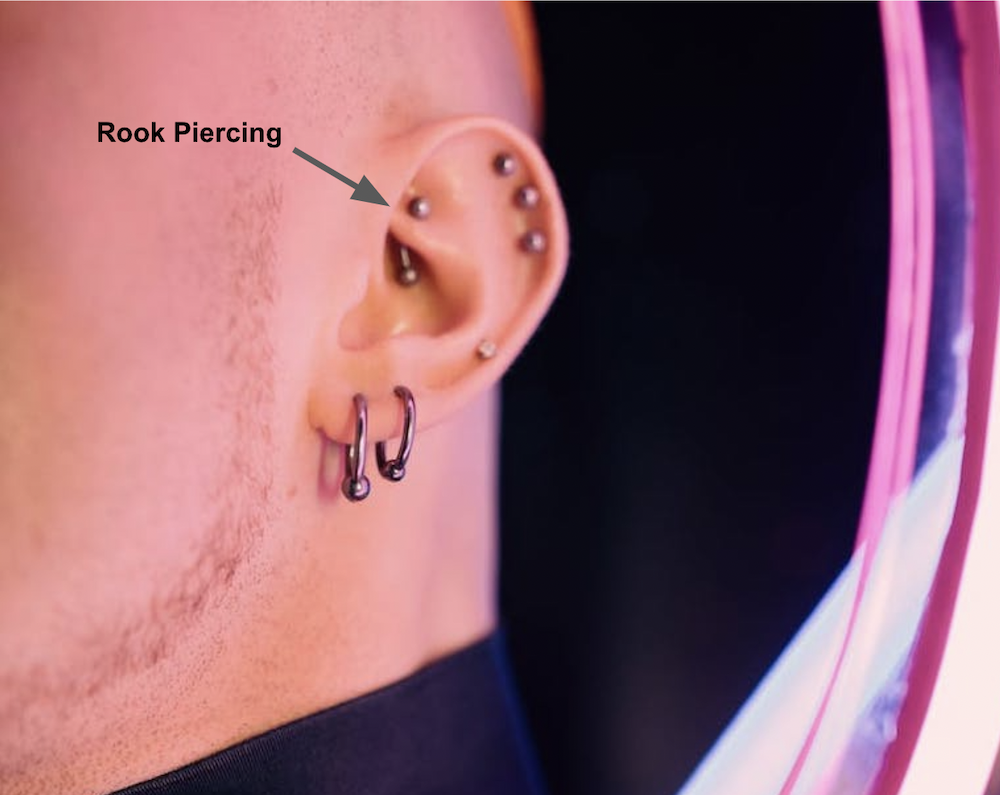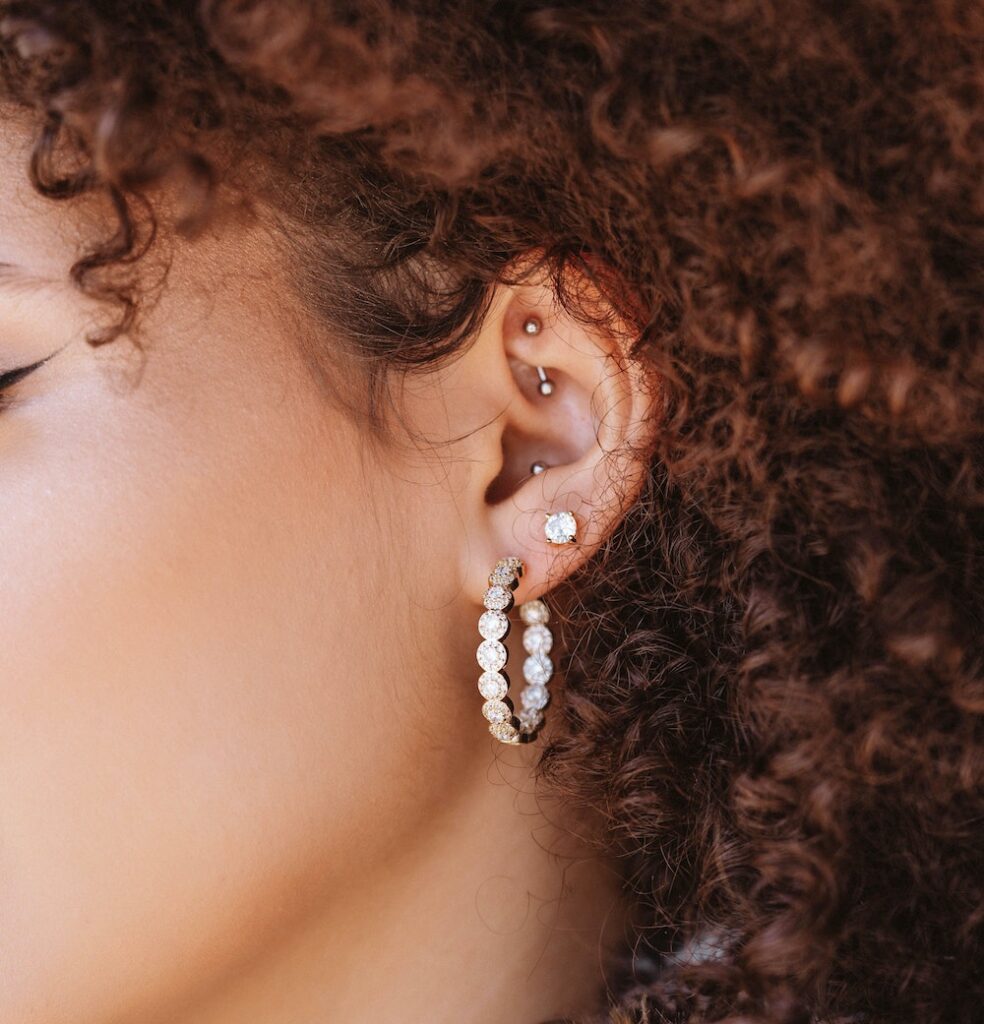Rook Piercing – Can This Type Help With Headaches?
A rook piercing is a vertical cartilage piercing that is said to possibly help with migraines
This article is more than 2 years old
Ear piercings have been the rage for some time now. Back in the day, aka many moons ago, ear piercings would just be the ear lobe, but today, there is nothing off limits when it comes to the ear and there are many individuals who have taken to decorating their ears much like they would a Christmas tree. One of the more popular ear piercings is called the rook piercing.
THE ROOK PIERCING IS A CARTILAGE PIERCING

The first thing you should know about a rook piercing is that it is a cartilage piercing. Now cartilage piercings have been popular for a long time, but these have centered around the outside of the ear. A rook piercing is directed at the inner folds of the ear.
Inside your ear, you have many different areas that have become popular piercing destinations. There are the lobes, the inner and outer conch, the forward helix, the helix, daith, tragus, industrial, and finally, the rook. You can see where they are all located in the diagram below.
As you can see from the diagram, the rook piercing is located in the uppermost ridge of your inner ear, located above the daith. These piercings are done vertically so both sides of your chosen jewelry can be seen. The location of the rook, though, can make for tricky access, so be sure if you are going for a rook piercing, you have an experienced piercer on hand.
A ROOK PIERCING IS SAID TO BE MORE PAINFUL THAN A STANDARD PIERCING

So, what you are saying when you tell your piercer you want a rook piercing is that you chew pain up and spit it out. Then again, you could be one who loses consciousness when a needle approaches you (so why get a piercing?). Whichever camp you fall in, just be prepared, because getting a rook piercing is not for the faint of heart.
The reason a rook piercing may sting a little bit is that the big, bad needle must be shoved through (violently and without care or concern) a layer of cartilage that is thicker than most other parts of your ear. Okay, we kid about the “violently and without care or concern” part, but you may feel this emotion as the needle makes its way through the rook.
As an FYI, the cartilage is a connective tissue that is thick and can be tough to get through. It definitely doesn’t have the softness of an ear lobe. It also takes much longer to heal because it has zero blood supply. On the bright side, the rook-piercing pain is said to be quick.
Those who have gotten a rook piercing claim that the pain they feel comes more from the crunch you hear as the needle is making its way through instead of the actual pain. Of course, everything is dependent on the piercer. An experienced piercer will most likely have you lay on your side on the chance that you may lose consciousness and they will also complete the piercing in one swift move.
A ROOK PIERCING MAY HELP WITH MIGRAINES
Believe it or not, the pain you experience from getting a rook piercing may eventually help you with ongoing headaches or migraines. This has yet to be scientifically proven, but there are many out there who claim that after they received their rook piercing, their headaches vanished. There are even some who had been experiencing horrible migraines claim that they no longer get any.
Those who make these claims say some of the thought processes comes from ideas behind acupuncture.
THERE ARE A NUMBER OF CONSIDERATIONS BEFORE GETTING A ROOK PIERCING
There are a few things you should think about before you go about your business of getting a rook piercing. The first thing you should do is ask yourself “why?” Okay, we are kidding, but not really.
- Make sure that whomever you go to for the piercing is experienced.
- The piercer should inform you of the risks and possible complications of the rook piercing as well as the necessary aftercare.
- Wherever you choose to go, be sure the place is clean and hygienic, the equipment being used is properly sterilized, and please make sure the piercer is wearing proper surgical gloves.
- Be sure that the needle being used is new.
- Do not have your rook piercing done with a piercing gun as you may end up with a damaged ear.
- Believe it or not, piercings may not be safe if you have certain medical conditions (such as diabetes, immune disorders, or heart conditions) so if this is the case, please check with your doctor before going for your rook piercing.
ROOK PIERCINGS CAN TAKE 6-9 MONTHS TO HEAL
So, you found the courage and decided to go through with a rook piercing. Congratulations. So, what’s next?
First of all, you should know that the average healing time of a rook piercing is anywhere from 6-9 months. Most cartilage piercings take time to heal, so be sure to consult with your experienced piercer before completely stopping your aftercare practice. You definitely don’t want to run into any issues after the pain you just went through.
- Make sure to avoid any unnecessary touching or moving of the rook piercing jewelry while the piercing is healing.
- Wash your hands before washing your piercing, which should take place 2-3 times a day with sterile saline solution.
- After you complete your thorough cleansing, be sure to pat dry it with a paper towel and not with a cloth towel. You will understand the first you try a cloth towel and get it snagged on the jewelry.
- Don’t rotate the jewelry while cleaning. This is a big deal for cartilage piercings because cartilage damages easily and moving the jewelry can cause trauma around the piercing which leads to scarring.
- If there is anything crusty around your piercing, do not pick at it.
- Do not use any beauty products near the piercing until it is healed.
- Keep a close eye on your rook piercing for infections. If one occurs, do not remove the jewelry unless your doctor tells you to.
CHANGING IT OUT COULD BE NECESSARY
This can be a major challenge the first few times you try it. You may, instead, want to go back to your piercer and have them change your rook piercing jewelry for you. Once you get used to it, then you can be confident to change it on your own. Be careful not to play too much with it because even a healed rook piercing can end up getting infected.
THE COST IS BETWEEN $30 AND $100
Maybe you know a piercer who will cut you a deal, but for the most part, expect to pay a professional rook piercer anywhere from $30-$100 for the piercer. Most time this price will not include the jewelry, so plan properly. Don’t cheap out on this piercing, you want to be confident you are getting the best piercer.
It all comes down to pain tolerance when you are considering a rook piercing. It has, though, become one of the more popular piercings, so there are plenty out there who see it as a means to an end, which is to have their ears layered with jewelry. Take some advice though, lay down before they jam that needle through.





